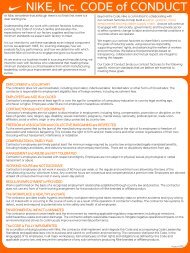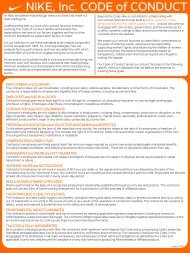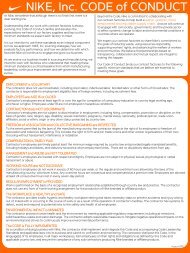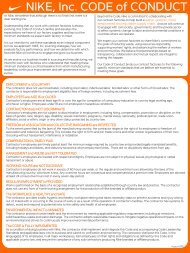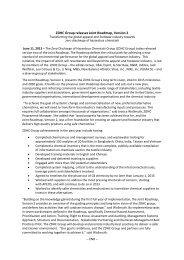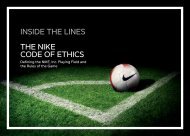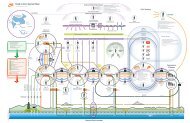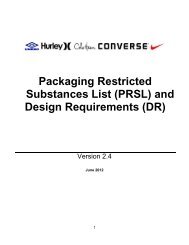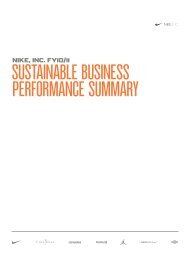COC CLS - Healthy Safety Environment - NIKE, Inc. - The Journey
COC CLS - Healthy Safety Environment - NIKE, Inc. - The Journey
COC CLS - Healthy Safety Environment - NIKE, Inc. - The Journey
You also want an ePaper? Increase the reach of your titles
YUMPU automatically turns print PDFs into web optimized ePapers that Google loves.
PERSONAL PROTECTIVE EQUIPMENT (PPE)<br />
- Bump caps/skull guards must be issued and worn for protection against scalp<br />
lacerations from contact with sharp objects. However, they must not be worn as<br />
substitutes for safety caps/hats because they do not afford protection from high<br />
impact forces or penetration by falling objects.<br />
• Foot protection:<br />
- <strong>Safety</strong> shoes or boots with impact protection are required to be worn when carrying<br />
or handling materials such as packages, objects, parts of heavy tools, that could be<br />
dropped; and for other activities where objects might fall onto the feet.<br />
- <strong>Safety</strong> shoes or boots with compression protection are required for work activities<br />
involving skid trucks (manual materials handling cars) or other activities in which<br />
materials or equipment could potentially roll over an employee’s feet.<br />
- <strong>Safety</strong> shoes or boots with puncture protection are required where sharp objects<br />
such as nails, wire, tacks, screws, large staples, or scrap metal could be stepped on<br />
by employees, causing a foot injury.<br />
• Hand protection:<br />
- Suitable gloves must be worn when hazards from chemicals, cuts, lacerations,<br />
abrasions, punctures, burns, biologicals, and harmful temperature extremes are<br />
present.<br />
- Glove selection must be based on performance characteristics of the gloves,<br />
conditions, duration of use, and hazards present. One type of glove will not work in<br />
all situations.<br />
• Skin protection (other than gloves):<br />
- Skin protection must be worn when there is a possibility of chemical splashes to the<br />
body, when the atmosphere may contain contaminants that could damage the skin<br />
or be absorbed by the skin, or when contaminants could remain on the street<br />
clothes of an employee. <strong>The</strong> amount of coverage is dependent on the area of the<br />
body that is likely to be exposed. For small controlled processes, an apron may be<br />
sufficient; for work above the head, a full body coverall may be required.<br />
d. Procedures for reporting and replacing damaged PPE.<br />
e. Maintained in clean, good working condition and stored properly.<br />
f. Provided and repaired free of charge by the employer.<br />
g. Inspected quarterly at a minimum.<br />
3. TRAINING—Training will be conducted at the time of initial assignment and at least annually<br />
thereafter. Training must cover as a minimum:<br />
<strong>Safety</strong> <strong>CLS</strong> – Page 3<br />
04.14.10



